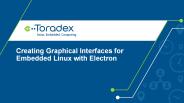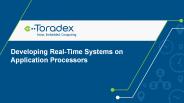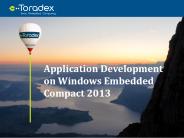Toradex PowerPoint PPT Presentations
All Time
Recommended
Toradex has unveiled its newest support feature i.e. the Toradex Community. This is an online community which will be readily accessible to its users and bridge the gap between them and the Toradex Engineers. Now, anyone can post their query on the community and get a direct response from the product development engineers at Toradex. Learn More: https://www.toradex.com/community
| PowerPoint PPT presentation | free to download
Ethernet compliance test is a hard task, but we make it much easier for you. Learn more from the basics to automotive Ethernet and how we do our tests, thereby simplifying things for you when designing a custom carrier board. http://bit.ly/2SBGTNO
| PowerPoint PPT presentation | free to download
Learn about the motivation behind the Toradex Embedded Linux BSP 3.x in our latest blog post, authored by Daniel Lang, CMO. The post also provides an overview of the new features in BSP 3.x.
| PowerPoint PPT presentation | free to download
Toradex is excited to announce the launch of the new easy-to-integrate Camera Module an add-on board for the Apalis family of System on Modules compatible with the Ixora carrier board.
| PowerPoint PPT presentation | free to download
Read our blog which describes our IoT parking lot demo and the technology behind it. We will also tell you how to use Azure IoT Hub to send messages between Azure services and devices to achieve the same level of communication we had in our demo. You will learn about the different modules we have used in our demo and how to develop simple applications using Azure IoT Hub.
| PowerPoint PPT presentation | free to download
Read our latest blog to find out how Harry (CTO of BestECG company) picks his ideal System on Module (SOM) partner once he decides to use System on Modules for building the next ECG machine. Harry knows that the SOM’s hardware is a commodity, and any vendor can offer a SOM based on a leading processor but only Toradex was able to match more than Harry’s expectations.
| PowerPoint PPT presentation | free to download
Toradex has partnered with Microsoft MTC Sao Paulo to create an IoT Workshop. This recurring workshop in Brazil is an engagement in the "hands-on" style wherein participants can experience the development of the IoT scenario; using Toradex’s Azure IoT Certified Colibri VF61, an embedded computer module featuring the NXP® Vybrid System-on-Chip (SoC) with ARM® Cortex®-A5 @ 500MHz. Making use of the embedded Linux and a node.js technology, the participant writes an application which sends the data from an Inertial Sensor to the Azure IoT Sensor Hub. It offers a great opportunity for the customer to see first-hand on how easy it is to create scalable IoT applications using Toradex’s embedded SoMs which are Azure Certified and the incredible resources Microsoft has developed for IoT under the Azure platform. Read full story here: https://www.toradex.com/news/toradex-partners-with-microsoft-for-iot-workshop
| PowerPoint PPT presentation | free to download
Touch functionality has become integral in the modern electronic devices and is instrumental in connecting users to their devices more closely. From resistive touch to capacitive touch and from single-touch to multi-touch, read our latest blog to find out in-depth about the various types of touch solutions that we provide here: https://www.toradex.com/blog/touch-solutions-for-windows-embedded-compact
| PowerPoint PPT presentation | free to download
Toradex has started shipping its Colibri iMX8X System on Module in the early access program, the module comes with up to four Arm® Cortex-A35 cores.
| PowerPoint PPT presentation | free to download
Toradex opens early access for selected customers to its new Apalis iMX8 System on Module (SoM) based on the NXP® i.MX 8QuadMax SoC, the highest performance variation of the i.MX 8 family.
| PowerPoint PPT presentation | free to download
We're excited about #Torizon, our new Linux-based software platform that makes developing and maintaining embedded software faster and simpler. Torizon comes free with all our SoMs, and the beta version is available now!
| PowerPoint PPT presentation | free to download
The concept of the Internet of Things is intrinsically related to the sending of data to the internet and its so-called cloud services. Learn how to join a Toradex Single Board Computer solution with the Azure IoT Hub service to send and receive messages in our next blog. It will help you to develop an IoT application which can read field sensors, present results, and demonstrate business intelligence. Toradex is an Azure IoT certified partner.
| PowerPoint PPT presentation | free to download
We’re excited to welcome Christmann into the Toradex Partner Program. Christmann brings forth its exciting 288 Core ARM® and 13’824 CUDA core microserver cluster with Toradex Apalis System on Modules.
| PowerPoint PPT presentation | free to download
Colibri iMX6ULL is the first Colibri module with optional certified Wi-Fi and Bluetooth connectivity. It features a single core ARM Cortex-A7 CPU.
| PowerPoint PPT presentation | free to download
Toradex has launched two new feature-packed System on Modules (SOM) based on the NXP® i.MX 7 series applications processors. The modules are designed to offer high-performance at ultra-low power consumption. They also come with advanced security features and heterogeneous multicore architecture based on ARM® Cortex-A7 and Cortex-M4 cores. It makes the modules an ideal fit for products aimed at the IoT market.
| PowerPoint PPT presentation | free to download
Toradex has announced the availability of a Technical Preview of Windows 10 IoT Core on an ARM-based System on Module (SOM). The Technical Preview is designed to test and evaluate the new features of Windows 10 IoT Core on an industrial grade embedded computing platform. This Technical Preview is based on Colibri T30 powered by NVIDIA®’s Tegra 3, a powerful ARM Cortex-A9 Quad Core embedded processor. To kick start the evaluation, Toradex is also offering a 'Starter Kit' for a limited time at a promotional price. The kit comes with a Colibri T30 SOM and Iris carrier board plus required accessories.
| PowerPoint PPT presentation | free to download
Toradex is proud to announce its participation in the early access program for the new NXP® i.MX 8QuadMax applications processor. Toradex will feature the NXP i.MX 8QuadMax on its pin-compatible Apalis Computer on Module form factor. Apalis iMX8 will be able to take advantage of the extensive ecosystem around Toradex Apalis System on Modules (SoMs).
| PowerPoint PPT presentation | free to download
In this guest blog post, Diamond Systems explains considerations to use Computer Modules for an application inside an emergency response vehicle. Diamond Systems is a valued member of the Toradex Partner Network providing off-the-shelf ready-to-use Carrier Boards for Toradex Modules.
| PowerPoint PPT presentation | free to download
Toradex partner TES Electronic Solutions GmbH presents a customizable 3D Surround View Turn-Key solution based on the Toradex Apalis iMX6 SoM that can be quickly adapted concerning the specific requirements of the targeted vehicle. Read more in their guest blog post here:.
| PowerPoint PPT presentation | free to download
Toradex's latest blog post on how to install Electron software on a Colibri iMX6 module, run basic programs to evaluate the software and, develop a basic GUI using Node.js, JS, HTML and CSS.
| PowerPoint PPT presentation | free to download
Learn about different approaches for the development of deterministic systems (Real-Time Embedded Systems) in NXP's i.MX 6 and i.MX 7 series applications processors. This includes the use of Embedded Linux with Real-Time Paths, Real-Time Linux, Xenomai and Heterogeneous multi-core processing with NXP i.MX 7 SoC. Watch our exiting webinar video here: https://www.toradex.com/webinars/development-of-real-time-systems-with-embedded-linux
| PowerPoint PPT presentation | free to download
Flash storage wears out, if they are accessed beyond a certain limit. Read our latest blog post on how Toradex ensures that the lifetime of the Flash storage, which is used on our SoMs, is improved.
| PowerPoint PPT presentation | free to download
Guaranteeing real-time and deterministic behavior on SoC-based systems can be challenging. In this blog post, we offer three approaches to add real-time control to systems that use a SoC running a feature-rich OS such as Linux. Source: https://www.toradex.com/blog/developing-real-time-systems-on-application-processors
| PowerPoint PPT presentation | free to download
The number of embedded devices that are connected to the internet is growing each day. Nowadays, they are installed majorly using a wireless connection. They need mobile network coverage to be connected to the internet. Read our blog which tells you about the various configurations to connect a device such as Colibri iMX6S with the Colibri Evaluation Board running Linux to the internet through the PPP (Point-to-Point Protocol) link. Read More: https://www.toradex.com/blog/how-to-use-gsm-3g-4g-in-embedded-linux-systems
| PowerPoint PPT presentation | free to download
Windows Embedded Compact 2013 is the latest product release in the Microsoft Embedded Compact family. WEC2013 introduces many new features when compared to Windows Embedded Compact 7.0 and Windows Embedded CE 6.0. A major advantage of using the new Windows Embedded Compact 2013 is having the .NET Compact 3.9 and we have tested it out for you in our blog. Read it to know about the various improvements made in WEC2013 (including multicore support) from the previous versions! https://www.toradex.com/blog/application-development-on-windows-embedded-compact-2013
| PowerPoint PPT presentation | free to download
Android 7.1 running on our NVIDIA TK1-based SoM: Apalis TK1! Credit goes to our partner Antmicro for offering this highly capable platform, along with a TK1 baseboard, to build products with cutting-edge performance and supreme UI. Read more at:
| PowerPoint PPT presentation | free to download
Circuit boards are extensively used across in the electronics industry. So much so that nowadays a circuit board designer is expected to be also proficient in the manufacturing technology apart from understanding electrical engineering. Read this article which will provide you with an insight on the various current and emerging technological trends prevailing in the manufacture of printed circuit boards.
| PowerPoint PPT presentation | free to download
One of the recent developments in the global System on Modul market comprises the expansion of Renesas Electronics’ Winning Combinations portfolio with the launch of a new scalable AI (artificial intelligence) Smart Mobility ARChitecture (SMARC) System on Module board solution designed by Renesas and developed via a partnership with RelySys Technologies.
| PowerPoint PPT presentation | free to download
The global computer on module market size reached US$ 1.5 Billion in 2022. Looking forward, IMARC Group expects the market to reach US$ 2.0 Billion by 2028, exhibiting a growth rate (CAGR) of 5.6% during 2023-2028. More Info:- https://www.imarcgroup.com/computer-on-module-market
| PowerPoint PPT presentation | free to download
Whether to use Android or Linux for your next embedded product development? Our partner Antmicro attempts to answer this question and also discuss on the differences and commonalities between these two operating systems.
| PowerPoint PPT presentation | free to download
Read our blog for the latest on demystifying the development of embedded systems using Heterogeneous Multicore Processing architecture powered SoCs! This might provide you with the jump start you need for your development.
| PowerPoint PPT presentation | free to download
Looking forward, the computer on module market value is projected to reach a strong growth during the forecast period (2022-2027). More info:- https://www.imarcgroup.com/computer-on-module-market
| PowerPoint PPT presentation | free to download
System on Module provides a system function in a single module by integrating digital and analog functions in a single board. These modules are generally used in applications such as embedded systems. Increasing adoption of IoT technologies globally accelerates the growth of system on module market.
| PowerPoint PPT presentation | free to download
Explore how you can introduce modularity in embedded product development to reduce time-to-market and cost, by using Computer on Module.
| PowerPoint PPT presentation | free to download
System on Module provides a system function in a single module by integrating digital and analog functions in a single board. These modules are generally used in applications such as embedded systems. Increasing adoption of IoT technologies globally accelerates the growth of system on module market.
| PowerPoint PPT presentation | free to download
Looking forward, the computer on module market value is projected to reach a strong growth during the forecast period (2021-2026). More info:- https://www.imarcgroup.com/computer-on-module-market
| PowerPoint PPT presentation | free to download
Europe System on Module (SoM) Market Size is estimated to hit USD 1 Billion By 2026. The Europe system on module market is gaining traction owing to the rising demand for embedded computing in the region. Embedded computing devices integrate SoM to control, monitor, and perform a specific function by executing commands. Microprocessors and microcontrollers integrated on these modules are the basic components used to operate embedded computing systems. These are used in various applications including office automation, home applications, banking & financial institutes, security, defense, healthcare, and automobile, among others. They offer additional features such as low power consumption, enhanced accuracy, increased reliability & adaptability, and high speed, accelerating market growth.
| PowerPoint PPT presentation | free to download
Get a sample brochure @ http://tinyurl.com/z7wym9e Integrated circuits and microchips have revolutionized industrial automation. The earliest example of a single board single purpose design is the PC/104, which had accessory boards to accommodate many application needs, but was as large as a 3.5-inch floppy disk. Chip manufacturers subsequently improvised and developed single board systems with smaller processors that can perform advanced functions. The system-on-module (SOM) and system-on-chip (SoC) are advanced computerised platforms, which comprise processors, I/O functions, and communication interfaces. They are ubiquitous and serve a broad range of applications starting from a calculator to industrial controls to space technology.
| PowerPoint PPT presentation | free to download
Haute cole de la Province de Li ge Cat gorie Technique Bachelier en Informatique et Syst mes Finalit Informatique Industrielle H.E.P.L. - S minaire Embarqu s ...
| PowerPoint PPT presentation | free to view
The Computer on Module Market is expected to grow at a steady rate by 2020. The embedded computer or computer on module is a major component of devices like servers and is needed for different rack mount applications. SOM also offers features for vendors for gaining a competitive edge over other technologies. Features like heat dissipation and reduction in the number of moving parts help to improve reliability and reduce the service cost of the equipment. Recently technological advances in the Computer on Module Market have helped the vendors to reduce the manufacturing cost and improve power consumption in the SOM computer industry. Request Sample PDF Brochure of the report @ http://www.marketintelreports.com/pdfdownload.php?id=gir2710
| PowerPoint PPT presentation | free to download
Es la encargada de administrar el sistema, consiste en un ... mejora de las memorias DDR (Double Data Rate), que permiten que ... DRAM (Double Data ...
| PowerPoint PPT presentation | free to view
Toradex has lift the curtain on its latest embedded computer unveiling based on the powerful CUDA® capable NVIDIA® Tegra® K1. The Apalis TK1 is the perfect System on Module for building advanced embedded products that require advanced performance & supreme graphics capabilities along with high-speed connectivity interfaces.
The global computer on module market is expected to grow at a CAGR of 9.4% during the forecast period, 2021–2031.











































